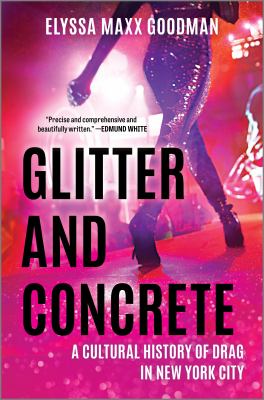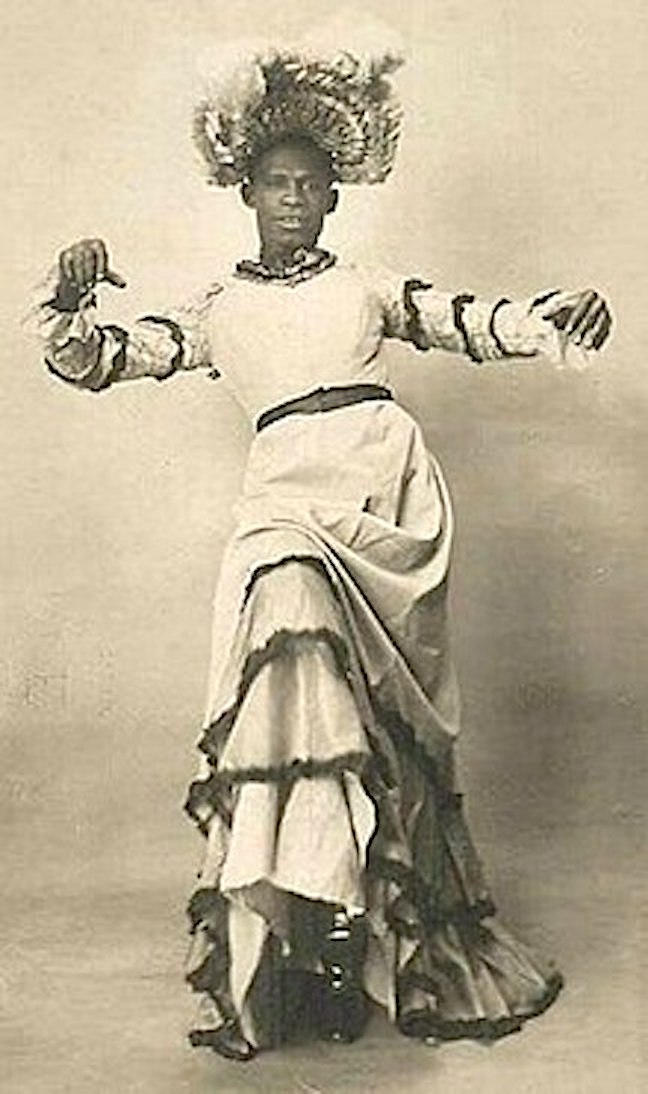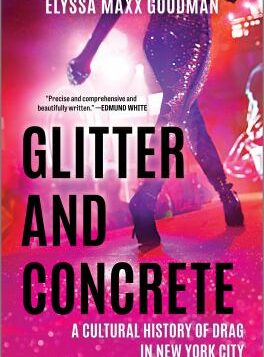 GLITTER AND CONCRETE
GLITTER AND CONCRETE
A Cultural History of Drag in New York City
by Elyssa Maxx Goodman
Hanover Square Press
464 pages, $25.90
IN THE SUMMER OF 1997, I gave birth to two beautiful drag babies on Pier 54 in Manhattan. We were at Wigstock, the raucous drag festival. Like many mothers, I neglected their development, but they have since grown into upstanding, fierce queens. Hundreds of drag mamas, whom Elyssa Maxx Goodman lovingly documents in Glitter and Concrete: A Cultural History of Drag in New York City, were far more committed to their drag careers and to nurturing newcomers to the culture of drag than was I.
While focused mainly on New York City, Goodman covers a wide historical frame from 1865 to the present with appropriate geographical forays beyond the Big Apple to give deeper cultural context to the history of drag. In the same vein, her subjects are far more diverse than the term “drag queens” suggests. She includes a wide range of “female illusionists,” female and male impersonators, cross-dressing vaudevillians, and burlesque performers. While the majority of these are males who dress (and undress) as women, she also includes the rich (but less documented) history of male illusionists. From the 1960s onward, the place of transgender and genderqueer people in society has been complicating and politicizing the question of who qualifies as a “drag queen” or “drag king.” Throughout her sensitive narrative, Goodman emphasizes the personal and cultural challenges gender non-conformists have faced in America, the political defiance that is drag, and its sheer liberatory deliriousness.

Since colonial times, masquerade balls and carnivals had been popular in the South and would evolve into the Mardi Gras extravaganzas that still draw tourists (gay and straight) to New Orleans. Ballroom and house masquerade parties became more popular through the late 19th century. A former slave, William Dorsey Swann (1860–1925; pictured on page 38)—known to friends as “the Queen”—has been credited as the first self-identified “queen of drag.” He was repeatedly arrested for hosting drag balls in Washington, D.C. A Washington Critic article (January 14, 1887) blared: “Raiding a ‘drag’: A ball where all the ladies were imitations”; and “Six colored men, dressed in elegant female attire, were arraigned … on a charge of being suspicious persons. … They nearly all had on low neck and short sleeve silk dresses, several of them with trains [and]corsets, bustles, long hose and slippers, and everything that goes to make a female’s dress complete.” Swann heroically (though unsuccessfully) petitioned President Grover Cleveland to pardon his ten-month jail sentence.
These drag parties even caught the attention of Victorian doctors, who reported on a stunning medical discovery: “an organization of colored erotopaths.” In an 1893 article in The Alienist and Neurologist, Dr. C. H. Hughes described
an annual convocation of negro men called the drag dance, which is an orgie of lascivious debauchery beyond pen power of description. … In this sable performance of sexual perversion all of these men are lasciviously dressed in womanly attire, short sleeves, low-necked dresses and the usual ballroom decorations and ornaments of women, feathered and ribboned head-dresses, garters, frills, flowers, ruffles, etc., and deport themselves as women. Standing or seated on a pedestal, but accessible to all the rest, is the naked queen (a male), whose phallic member, decorated with a ribbon, is subject to the gaze and osculations in turn, of all the members of this lecherous gang of sexual perverts and phallic fornicators.
These hysterical medical reports echoed contemporaneous European articles uncovering the disorder of “sexual inversion” or “contrary sexual sensation”—precursors of the medical diagnosis of “homosexuality.”
Not surprisingly then, many gender impersonators of the early 20th century insisted on their “normal” sexuality. Some trumpeted their conventional marriages to escape the cultural prejudice associating gender deviance with sexual deviance. Gillian M. Rodger in Just One of the Boys: Female-to-Male Cross-Dressing on the American Variety Stage (2018) documented the centuries-long tradition of women playing men on opera, theater, and vaudeville stages. Male impersonators like Annie Hindle (“The Great Hindle”), Ella Wesner, and Kitty Dorner were tremendously successful in turn-of-the-century vaudeville, though they are less well known than the tuxedoed performances of Gladys Bentley and Marlene Dietrich. Glitter and Concrete might have benefited from some pictures of them, as well as of besequinned drag divas.
As we progress beyond the 1960s, the book turns into a catalog of drag, trans, and queer performers. The individual biographies, the details of performance innovations, and the mob connections of the clubs give way to brief name-dropping. Today one can watch a 24/7 stream of global fabulosity on World of Wonder Plus or even mainstream broadcast TV. We’re Here, on HBO, brings sequins, stilettos, and boas to the stodgiest towns of America—drawing out queer pride and reactionary prejudice. Everyone is moved to tears as the drag-mobile disappears down dusty roads of the Great Plains.
Goodman acknowledges up front that she is using “drag” as a shorthand to cover a variety of phenomena. One distinction made a century ago was that between professional, “gender illusionists” (who may or may not have been homosexuals) and cross-dressing “pansies” or “perverts.” An overlapping distinction might be made between cross-dressing as a public versus a completely private activity. Fetishistic transvestism, for example, is not covered in this book. A conflict that emerges more explicitly from the mid-20th century is between drag queens (cross-dressing gay men) and the “passing” of transsexual women. RuPaul stumbled into this controversy when he suggested in 2018 that transgender women should not be accepted as contestants on his Drag Race TV show. He was promptly attacked on social media, and apologized. This brings us to feminist critiques of drag: Is it a sexist parody of femininity, or does it simply highlight the performativity of normative gender?
Goodman mentions these issues but doesn’t dwell on the more academic, theoretical interpretations of drag. Instead, she warmly conveys her own delight in drag and its spectators, gay and straight, over the past century. She doesn’t fully explore the drag queens’ or kings’ pleasure and empowerment in taking on a fierce drag persona. This is much better portrayed on RuPaul’s Drag Race or We’re Here. I’m sure it is well known to readers who have swung a feather boa around their neck.
My own venture into drag began under the guise of didactics. In the fall of 1990, I was teaching a junior seminar at Harvard on the medical history of sexuality. I had just spent the summer in Berlin and discovered the vibrant queer culture still sparkling there as if it were the Roaring Twenties. I chastised myself for never having tried drag myself, so throughout the semester I progressively took on more feminine clothes to teach my seminar. I got strange looks from the faculty, but I had perfect attendance! The last day of class, I dressed in a business suit. “I’m sorry, Vernon,” one young woman had to interrupt class, “but I’m having a hard time paying attention to you. You look like someone my parents would want me to marry!”
Drag, both female and male, worked well as a pedagogical tool. It also forced me to confront my own insecurities as a gay man, as a young academic, and simply as an introvert. Well, the fabulousness of “Venus” had been unleashed at parties around campus, at LGBT conferences around the U.S., and at Wigstock on Pier 54. I even walked the whole of Boston Pride in my six-inch stiletto thigh-high boots and lace-up leather bustier. Grrrl, I kicked ass!
Drag queens and queer people still need to be courageous, as we are now the target of the latest iteration of the Culture Wars. Bathroom battles, transgender affirmative health care, the teaching of LGBT history, and drag queen story hour seem to preoccupy many a GOP legislator. The current Speaker of the House, Mike Johnson, is convinced that these queer issues are the “dark harbinger of chaos and sexual anarchy that could doom even the strongest republic.” Hopefully, readers can keep in mind the fun as well as the fierceness of drag as they take in the spectacle of New York drag culture in Glitter and Concrete.






